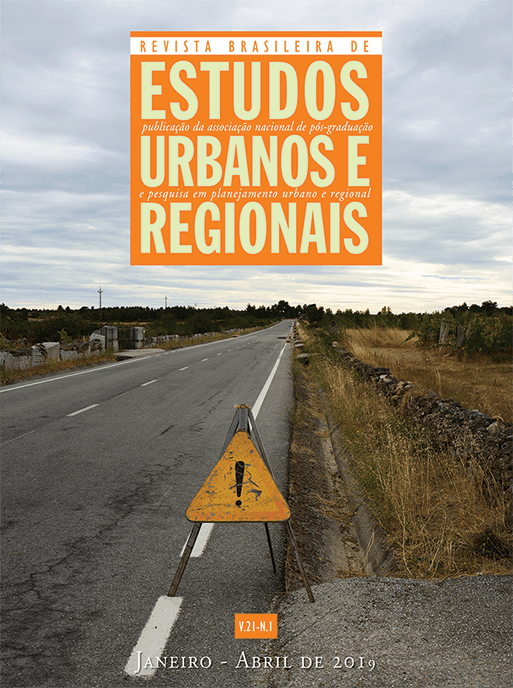Integração econômica vs evitamento social: analisando relações de bairro entre a favela de Calabar e os condomínios de elite circundantes
DOI:
https://doi.org/10.22296/2317-1529.2019v21n1p117Palabras clave:
Efeito-território, Pobreza urbana, Favela, Segmentação social, Estruturas de oportunidade, Estigma territorialResumen
Esta pesquisa analisa o impacto do efeito-território nas condições de vida de trinta ha
bitantes de Calabar, uma favela localizada em uma área de classe alta em Salvador, Bahia. Foi adotado um
arcabouço metodológico tripartite para explorar as dimensões materiais, sociais e simbólicas do efeito
território com base em um conjunto de entrevistas. Com relação à dimensão material, as interações entre
classes por meio das relações empregatícias são fomentadas pela proximidade geográfica; no entanto, a
segmentação em relação ao acesso a escolas, hospitais e lazer reforçou as hierarquias sociais. Na dimensão
social, um alto grau de coesão e solidariedade resultou em implicações positivas nos processos de busca de
emprego, acesso a recursos e fortalecimento da identidade territorial. No tocante à dimensão simbólica, a
discriminação estatística resultou em efeitos deletérios na integração econômica. Em conclusão, a hipóte
se de um ambiente de oportunidades enriquecedoras deve passar por um escrutínio cuidadoso, visto que
a integração econômica dos habitantes não cria pontes entre abismos sociais nem impede a discriminação
por localização.
Descargas
Citas
ANDRADE, Luciana T.; SILVEIRA, Leonardo S. Efeito-território. Explorações em torno de um conceito sociológico. Civitas, v. 13, n. 2, p. 381-402. 2013.
ATKINSON, Rowland; KINTREA, Keith. Area effects: what do they mean for British housing and regeneration policy? European Journal of housing research, v. 2, n. 2, p. 147-166. 2002.
BRIGGS, Xavier de S. Brown Kids in White Suburbs: Housing Mobility and the Many Faces of Social Capital. Housing Policy Debate, v. 9, n. 1, p. 177-221. 1998.
CASTEL, Robert. Les métamorphoses de la question sociale: une chronique du salariat. Paris: Fayard, 1995
CONDER; INFORMS. Painel de informações: dados socioeconômicos do município de Salvador por bairros e prefeituras-bairro /Sistema de Informações Geográficas Urbanas do Estado da Bahia. Salvador da Bahia: Secretaria de Desenvolvimento Urbano and Sistema de Informações Geográficas Urbanas do Estado da Bahia, 2016.
GANS, Herbert. Culture and Class in the Study of Poverty: An Approach to Anti-Poverty Research. In: MOYNIHAN, David Patrick Moynihan (Org.). On Understanding Poverty: Perspectives from the Social Sciences. New York: Basic Books, 1969. p. 229-259.
GRAIF, Corina; GLADFELTER, Andrew S.; MATTHEWS, Stephan A. Urban Poverty and Neighborhood Effects on Crime: Incorporating Spatial and Network Perspectives. Sociology Compass, vol. 8/9, p 1140-1155, 2014.
HANNERZ, Ulf. Soulside: inquiries into ghetto culture and community. New York: Columbia University Press, 1969.
HÄUßERMANN, Hartmut. Armut in der Großstadt. Die Stadtstruktur verstärkt soziale Ungleichheit. Informationen zur Raumentwicklung, v. 3 and 4, p. 43-157. 2003.
KAZTMAN, Ruben. Activos y estructura de oportunidades: estudio sobre las raíces de la vulnerabilidad social en Uruguay. Montevideo: Oficina de la Cepal en Montevideo, 1999.
LEWIS, Oscar 1968. The culture of poverty.” In On Understanding Poverty: Perspectives from the Social Sciences, edited by David P. Moynihan, 187–220. New York, NY: Basic Books.
MARQUES, Eduardo C. L. Redes sociais, segregação e pobreza. São Paulo: Editora Unesp, 2010.
MASSEY, Douglas S; DENTON, Nancy. American Apartheid: Segregation and the Making of the Underclass. New York: Harvard University Press, 1993.
MURRAY, Charles. Losing ground: American Social Policy, 1950-1980. New York: Basic Books, 2015.
MUSTERD, Sako; MARCINCZAK, Szymon; VAN HAM, Maarten; TAMMARU, Tiit. Socio-Economic Segregation in European Capital Cities: Increasing Separation between Poor and Rich. Bonn: Institute for the Study of Labor, 2015.
NIESZERY, Andrea. Soziale Segregation, Quartierseffekte und Quartierspolitik. Ein deutsch-französischer Vergleich. 2013. 343 F. Tese (Doutorado em Geografia) - Mathematisch-Naturwissenschaftliche Fakultät II. Humboldt-Universität zu Berlin, Berlin
PAUGAM, Serge. Die elementaren Formen der Armut. HIS: Hamburg, 2008.
PNUD. Atlas do Desenvolvimento Humano no Brasil (accessed: January, 13 th, 2018). http://www.atlasbrasil.org.br/2013/, 2010.
RIBEIRO, Luiz C. de Q.; KOSLINSKI, Mariane C. Efeito metrópole e acesso às oportunidades educacionais. Revista Eure, v. 35, n. 106, p. 101-129. 2009.
RIBEIRO, Luiz C. de Q.; LAGO, Luciana C. A Oposição Favela-Bairro no Espaço Social do Rio de Janeiro. São Paulo em Perspectiva, v. 15, n. 1, p. 144-154. 2001.
ROBERTS, Bryan R. Globalization and Latin American Cities. International Journal of Urban and Regional Reserach, Hoboken, N.J., v. 29, n.1, p. 110-123, 2005.
SAMPSON, Robert J. Chicago and the Enduring Neighborhood Effect. Chicago: The University of Chicago Press, 2012.
SIM. Sistema de Informação Municipal de Salvador. (Accessed: : January, 13 th, 2018). http://www.sim.salvador.ba.gov.br/, 2010.
SMALL, Mario L. Villa Victoria: The Transformation of Social Capital in a Boston Barrio. Chicago: University of Chicago Press, 2004.
SMALL, Mario Luis; NEWMAN, Katherine. Urban Poverty After The Truly Disadvantaged: The Rediscovery of the Family, the Neighborhood, and Culture. Annual Review of Sociology, Palo Alto, v. 27, p. 23-45, 2001.
TELLES, Edward E. Residencial segregation by skin color in Brazil. American Sociological Review, v. 57, n. 2, p. 186-197. 1994.
TORRES, Haroldo da Gama et al. Pobreza e espaço: padrões de segregação em São Paulo. Estudos Avançados, São Paulo, v. 17, n. 47, p. 1-32, 2003.
WILSON, William J. The Truly Disadvantaged: The Inner-City, the Underclass and Public Policy. Chicago: University of Chicago Press, 1987.
Publicado
Cómo citar
Número
Sección
Categorías
Licencia
Derechos de autor 2019 Revista Brasileira de Estudos Urbanos e Regionais

Esta obra está bajo una licencia internacional Creative Commons Atribución 4.0.
Los autores que publican en esta revista aceptan los siguientes términos:
1) Los autores que publican en la RBEUR conservan los derechos sobre su obra y otorgan a la revista el derecho de primera publicación, realizada bajo la Licencia Creative Commons Attribution que permite compartir la obra y asegura el reconocimiento de la autoría y del vehículo de publicación original, la RBEUR.
2) Los autores son libres para publicar y distribuir de forma no exclusiva la versión del trabajo publicado en esta revista (por ejemplo, publicar en repositorio institucional o como capítulo de un libro), reafirmando la autoría y el reconocimiento del vehículo de publicación original, la RBEUR.











.png)

